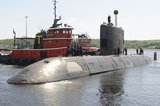US nearshore patrol explores its place in Great Power world
The revamp of the US Navy’s nearshore maritime patrol capability continues apace following the merger in 2012 of the Expeditionary Combat Command (NECC) Maritime Expeditionary Security Squadrons and Riverine Squadrons, which formed the Coastal Riverine Force (CRF).
The outcome of that saw the CRF giving up riverine patrol to focus on maritime security, oftentimes spent in ports and anchorages area. Into this, new patrol craft have been adopted, with the service offering a different kind of leadership opportunity to prospective naval commanders.
Into this, is the challenge in determining what sort of additional or new roles such a force might
Already have an account? Log in
Want to keep reading this article?
More from Naval Warfare
-
![Is the US Navy’s Golden Fleet initiative achievable?]()
Is the US Navy’s Golden Fleet initiative achievable?
The effort to provide the US Navy with Trump-class battleships might face financial, production and doctrinal obstacles.
-
![How will SAFE shape naval procurement for Canada and its highest-receiving members?]()
How will SAFE shape naval procurement for Canada and its highest-receiving members?
Canada’s inclusion on the EU’s Security Action for Europe initiative is set to enhance the country’s defence procurement strategy with important implications for some of its naval programmes, while Poland and Romania have also secured significant SAFE funding.
-
![Thales wins DE&S contract for portable autonomous command centres]()
Thales wins DE&S contract for portable autonomous command centres
The agreement to provide portable autonomous command centres to the UK Royal Navy will enhance the service’s Mine Counter Measure operations and further integrate autonomous and uncrewed systems into its fleet.
-
![Maritime defence in the Mediterranean faces challenges from vulnerable land power]()
Maritime defence in the Mediterranean faces challenges from vulnerable land power
As an indispensable energy crossroads, the Mediterranean is at serious risk from grey zone disruption. As navies increasingly employ AI data centres, what happens when cutting-edge defence technologies rely on the very infrastructure most susceptible to hybrid tactics?























